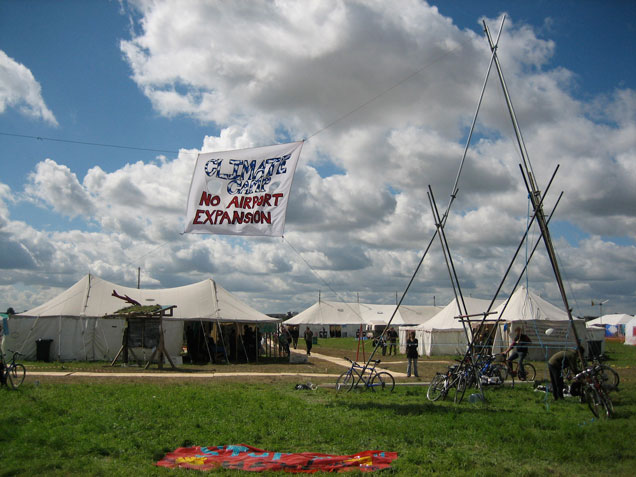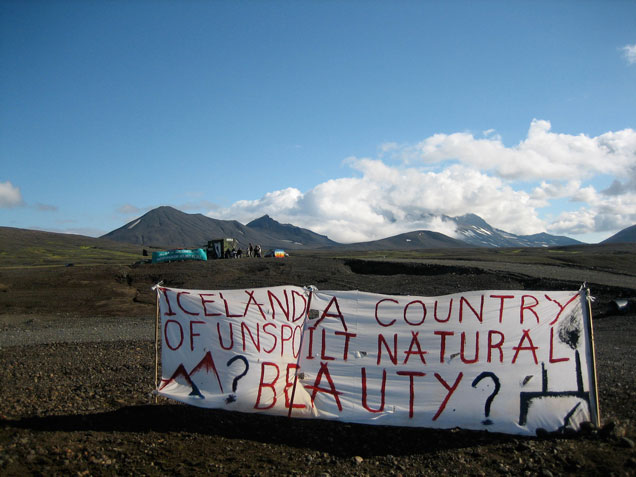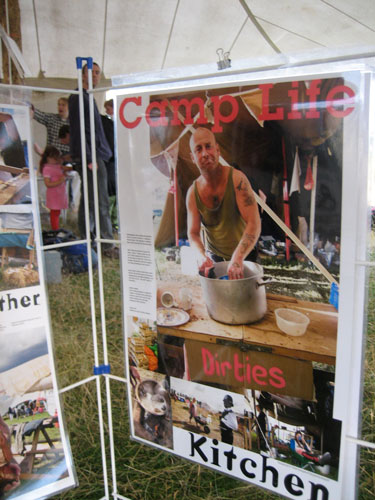Issues- Art Projects- Critical Conversations- Lectures- Journal Press- Contact- Home-

- Anna Feigenbaum, Patrick McCurdy and Fabian Frenzel
Heathrow Airport Climate Camp. 2007 (photo by Fabien Frenzel).
#9
bios
buy
(editors note: this is a slightly edited excerpt from a book by the same authors and title- Protest Camps, Zed Books 2013)
Whether in the forests of Tasmania or the crowded streets of Thailand, to function at the most basic level as sites of ongoing protest and daily living, protest camps need to figure out where people will sleep, what they will eat, and where they will go to the bathroom. Beyond basic bodily needs, as sites of ongoing protest, protest camps develop ways for protesters to communicate with one another and methods for organising their campaigns, direct actions and day-to-day operations. They also often provide legal support and medical care to protesters. Additionally, many protest camps contain spaces for well-being, including places for prayer, meditation, entertainment, socialising, education and cultural exchange. To create these spaces, protest campers bring together and develop particular infrastructures and practices. As campers build communal kitchens, libraries, education spaces and solar-powered showers, they become entangled in the objects and processes that form experiments in alternative ways of living together.
In this way protest camps are at once protest spaces and homeplaces. Building on the work of bell hooks (1990), Jeff Juris (2008) refers to alter-globalisation convergence centres as ‘homeplaces’. For hooks, the home place is not something structurally already there, but rather something that is made. Describing spaces for refuge and nurturing built by black women to resist capitalist patriarchy, hooks argues that the ‘task of making homeplace’ involves constructing a safe space for growth, development and to ‘nurture our spirits’. For hooks, it is a shared task, a task of ‘making home a community of resistance’ (hooks 1990: 184). This idea echoes much Marxist feminist work on the reproductive labour of homemaking and bio-politics (Cowan 1985; Federici 2004), while also invoking the structural home itself as something active, affective and vibrant.
The facilities built at protest camps highlight the lack of free, public infrastructures available to people in general for gathering, eating, discussing, relaxing or playing. Much of the impact of protest camps on the public comes from their visible disruptions of the normative routines of daily life, which see us move primarily through privatised places and spaces of consumption. Protest camps interrupt the ways in which people move through ‘public’ spaces, how they see a park or forest, a parking lot or government lawn. As convergence spaces, protest camps bring strangers together. This disruption is particularly true with protest camps formed of, and focused on, populations deemed illegitimate and out of place (or worthy of no place); such as refugees, the homeless and impoverished, and those divested of their land. In these camps, the home place, as a space of bodily vulnerability and scant resources, is often intentionally exposed to the public, mirroring the unjust conditions of the nation state back to itself and its citizens.

Protest Camp in Iceland (photo by Fabian Frenzel)
The work involved in re-creating these basic infrastructures whether intentionally or not, is frequently regarded as being outside the political sphere. It is seen as an add-on to the real business of meetings and direct action. Sometimes coded as ‘women’s work’, the physical and affective or emotional labour – as well as the materials and spaces – that go into caring for our bodies are often overlooked and undervalued. More than a mere backdrop or accessory to action, the people, objects and operations required to keep camps running are essential to the political life of the camp. These practices of re-creation are, in their own right, political acts that have much to tell us not only about the nature of protest camps, but also about social movement and cultural politics more generally. As exposed and vulnerable places of politics, protest camps render reproductive labour and the infrastructures in which this labour takes place visible. The social and biological becomes political.
In this paper we discuss infrastructures and practices of social reproduction in relation to claims to autonomy and exceptionality. We offer only a brief overview of some of the major points of contestation around social reproduction. An entire book could be written on each, they deserve more time and consideration than we can provide here.
Following Foucault, we consider the employment of re-creational infrastructures as ‘bio-political’. While Foucault is mainly interested in the ways in which the state has attempted to regulate and exercise power in this bio-political fashion (for example in prisons and hospitals) his ideas have been mobilised to understand the bio-politics of political life, or what feminists have long termed the importance of the ‘personal as the political ‘in democratic strategy. The assumption that results from the application of the idea of bio-politics to the work of social change and anti-capitalism draws from authors like Frederici who has pointed to the way that capital exploits the ‘free’ reproductive labour of women. In her work on the ActUp movement, Frederici argues that political movements need to—and can—move beyond symbolic protest by re-creating structures of solidarity and social care (Frederici 2012).
The majority of discussions around care and social reproduction in social movements come from indigenous, feminist, ecological and anarchist literature. Indeed it was these approaches that early on questioned the blind spots of critical theories in relation to care and social reproduction, including the traditionally Marxist analysis of society (Hennessy and Ingraham 1997). Framing this in terms of a bio-political struggle, we could say that the focus here is on the expansion of basic human relations. In protest camps, tensions between bio-politics and emancipatory politics come to the fore. In the past forty years of protest camp history—as it has run alongside post-1968 women’s liberation movements in many countries—we have seen an increasing (if not always consistent) attention to questions of care. While the protest camp has been home to experiments and innovations in how care is perceived and organised, this also has not come without contestation.
B. Bio-politics in Protest Camps
In the 1970s and 1980s, many feminist social movements mobilized consensus decision-making, an emphasis on the importance of child care, and critiques of gendered divisions of labour in tasks like cooking and cleaning. The international women’s peace camps of the 1980s arguably emerged, in a large part, from women’s desire to take part in autonomous separations that claimed space for women to organize themselves apart from the men who had dominated their movements, workplaces and home lives. Carving out a space for women to engage in the process of making a protest camp, the handbook of reflections from the Puget Sound women’s peace camp, opens by telling readers, ‘The title of this book [Ordinary Women] distills the essence of our work, which is to demystify political action—any woman who can plan a gathering of friends can plan a political action’ (Participants of the Puget Sound Women’s Peace Camp, n.d.).
It goes on to describe how their feminist politics encountered direct action, indigenous and ecological perspectives, drawing attention to practices of well-being and care:
The Puget Sound Women’s Peace Camp is based on the principles of non-violence and of feminism. A< non-violent, feminist way of living seeks cooperation, not domination, and includes respect for people’s physical and spiritual well-being and a love of the earth and her creatures. We strive to hear and include each of our voices equally in group decisions and to provide a supportive place for women to learn new skills (Participants of the Puget Sound Women’s Peace Camp, n.d.).
Within the UK’s anti-roads protests during the 90’s, internal questions around divisions of labour and well-being were often pushed to the side lines. The ‘real work’ of direct action and maintaining oppositional territories through extensive barricading and tunnelling often superseded re-creational concerns. When protesters attempt to carry their tactics of protest camping into the city of London, their disregard came to the fore. In 1996, drawing inspiration from the anti-roads movement, people squatted unused land around Claremont Road to create a commune based on Diggers ideals. The ‘Pure Genius’ occupation sought to make land common and create autonomous re-creation infrastructures based on permaculture practices. Their encampment lasted for over five months but, according to Doherty (1998) faced numerous challenges around how to provide for people’s needs.
‘The eviction stimulated much discussion about the site, much of which focused on its internal problems: articles by John Vidal and George Monbiot in the Guardian of October 16 concentrated on 'how few pissheads it takes to wreck a site'. It is accepted that the site itself had serious problems (...)At the same time it becomes easy for people to be scapegoated as the reason for the problems of the site and for the attention to be deflected away from ambiguities in the formation and conceptualisation of the campaign (Featherstone 1997: 56).
In a number of reflections published in the Earth First!’s Journal Do or Die campers reflected on these problems (see Do Or Die Issues 6-9). Of particular interest is a reflection in issue 6 on the Newbury Bypass protests. One section of this reflection, subtitled ‘Personal problems get in the way of campaigning’ is followed by an editor’s note:
The following two paragraphs put across ideas that members of the idiotorial [sic] collective heavily
disagreed with. Rather than not include the piece, or edit it so that it 'conformed', we decided to print it
with a reply at the end. We hope this aids discussion and debate.
This exchange highlights the reflective process many in the anti-roads movement and in the broader autonomous social movements of the time were working through. The article’s author goes on to argue that: Whether you call them dime-bars, energy vampires, lunch-outs, or whatever, it is undeniable that personal problems can often seriously hinder the effectiveness of a campaign. The free-living, utopian lifestyle of protest camps attracts all sorts of people (and rightly so), but sometimes for the wrong reasons. There can be a conflict between the view that everyone should be free to live their own individual life, and the right for a community to exist free of disruption. This conflict should not exist: a road protest camp is not a community centre to deal with people's problems- it is neither desirable or feasible.
(http://www.eco-action.org/dod/no6/newbury_critique.htm).
Here the author rejects the notion that re-creational infrastructures and practices around care and social reproduction have any place in a direct action camp. Claims to autonomy come purely from the antagonistic gesture, not from the collective effort to create alternatives to the status quo.
Objecting to this view, the editors respond in a section titled: ‘If we can't sort out each other, how are we meant to sort out the world?’ They write that the author:
Seems to suggest that we should leave our emotional baggage at home and if we begin to crack up, leave the campaign - effectively, we are discarded when we are no longer 'productive'. But I would argue that the primary aim of campaigns is to rebuild communities and create a movement that can really transcend industrial capitalism as a whole. The rather minor effect we have on industry is less important than the way in which our campaigns affect us and our movement. In a socially fragmented world, the mad arena of campaigning is, frighteningly, one of the few opportunities we have for ‘group therapy' and individual and collective evolution.
(http://www.ecoaction.org/dod/no6/newbury_critique.htm).
This discussion shifts the debate by placing questions of care and support to the centre of the autonomous project of the protest camp. It de-stabilises, or to use Sarah Ahmed’s terminology, it re-orients the ‘mad subject’ and the protest camp in such a way that neither is seen as a failure. The camp does not fail because it has mad people. Nor do people fail because they cannot (or can no longer) produce the campaign. Rather, the failure—the place where more work must be done—concerns how we align questions of individual wellness, community well-being, and antagonism toward the state. There is no single formula. There are only better experiments; experiments that learn from past movements; experiments that build organized, accountable infrastructures and practices of care into everything from kitchen cleanup to the general assemble. Here we start to see an articulation of an emancipatory bio-politics.

Bibliography
Ruth Schwartz Cowan. More Work for Mother. s.l.: Basic Books, 1985.
Brian Doherty. "Opposition to Road-Building", Parlimentary Affairs 51. 1998. 370 - 383.
D. J. Featherstone. "Reimagining the Inhuman City, The "Pure Genius" and Occupation, Soundings: A Journal of Politics and Culture 7. 1997.
Silvia Federici. Caliban and the Witch. New York; Autonomedia, 2004.
Silvia Federici. Revolution at Point Zero. Oakland: PM Press 2012.
Rosemary Hennessy, Chrys Ingrahm, editors. Materialist Feminism, A Reader in Class. New York: Routledge, 1997.
Bell Hooks. Yearning: Race, Gender and Culture. Boston: South End, 1990.
Jeff Juris. Networking Futures. Durham: Duke University Press, 2008.